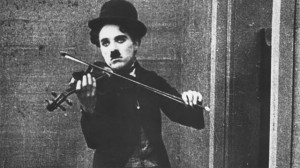Almost 100 years after it was made, the Charlie Chaplin film The Vagabond, still leaves audiences laughing and swooning, no matter where it plays. I’ve seen children on the Indian subcontinent laughing uproariously at Chaplin’s antics the same way that elderly movie-goers did on a different occasion in California. Chaplin’s silent films are hypnotic. The fact that no words are audible adds to their allure. But “silent film” can be a misnomer. Many silent films were made to have a musical accompaniment, and modern screenings of anything by Chaplin, Lon Chaney, and other silent-era greats are almost expected to have an aural component.
That’s where Jon Mirsalis comes in. An accomplished pianist who’s one of the world’s foremost historians on Chaney’s works and silent film in general, Mirsalis will accompany three Chaplin shorts that are playing at the Castro Theatre on Saturday, January 11, 2014. The films — The Vagabond, The Cure, and Easy Street — are screening as part of The Little Tramp at 100: A Charlie Chaplin Centennial Celebration, which is being presented by the San Francisco Silent Film Festival. Mirsalis interprets each film scene on the spot. How to play for a silent film? For Mirsalis, it’s about improvisation. And it’s about creating sheets of sound that — in a counter-intuitive way — are both noticed and unnoticed. The best musical accompaniments to silent films, Mirsalis says, stay in the background.
“What makes a good score is, first, you don’t want to call attention to yourself,” he says. “There are and have been accompanists who love to put in what I call musical gags. One accompanist would play, whenever there was a fire sequence, the song Blaze Away. If you know the song, it’s ‘Ha, ha. Isn’t that cute?’ But that’s a terrible thing to do. Because it takes people off the film. I should be invisible. In fact, the best compliment that people give me when a film is over is to come up to me and say, ‘You began playing the film and for the first minute or so, I was conscious you were playing. And then I just tuned you out.’ And people are often apologetic. They’ll say, ‘I completely forgot you were there until the end credits came on and you stood up and people applauded.’ That’s the best compliment, because that’s the way it’s supposed to work. The music is supposed to provide the mood of the film. Even a film today, like a John Williams score for Star Wars or Indiana Jones or Lincoln — you don’t sit there and say, ‘Wow, this is a great score.’ You are sucked into the movie.”
In the hey-day of silent films, between the 1890s and 1920s, about 20,000 were made, according to Mirsalis. After “talkies” appeared around 1929, and the demand for silent films badly ebbed, movie studios destroyed thousands of original-print silent films, including films by Chaney and other major stars. The only reason some of these films still exist: Copies happen to have been held in archives. Even today, rare silent films are occasionally found in old houses and old storage spaces. Chaney, for example, made more than 150 films, but a relative few survive, Mirsalis says. Chaney’s work for Universal Studios is almost completely lost.


